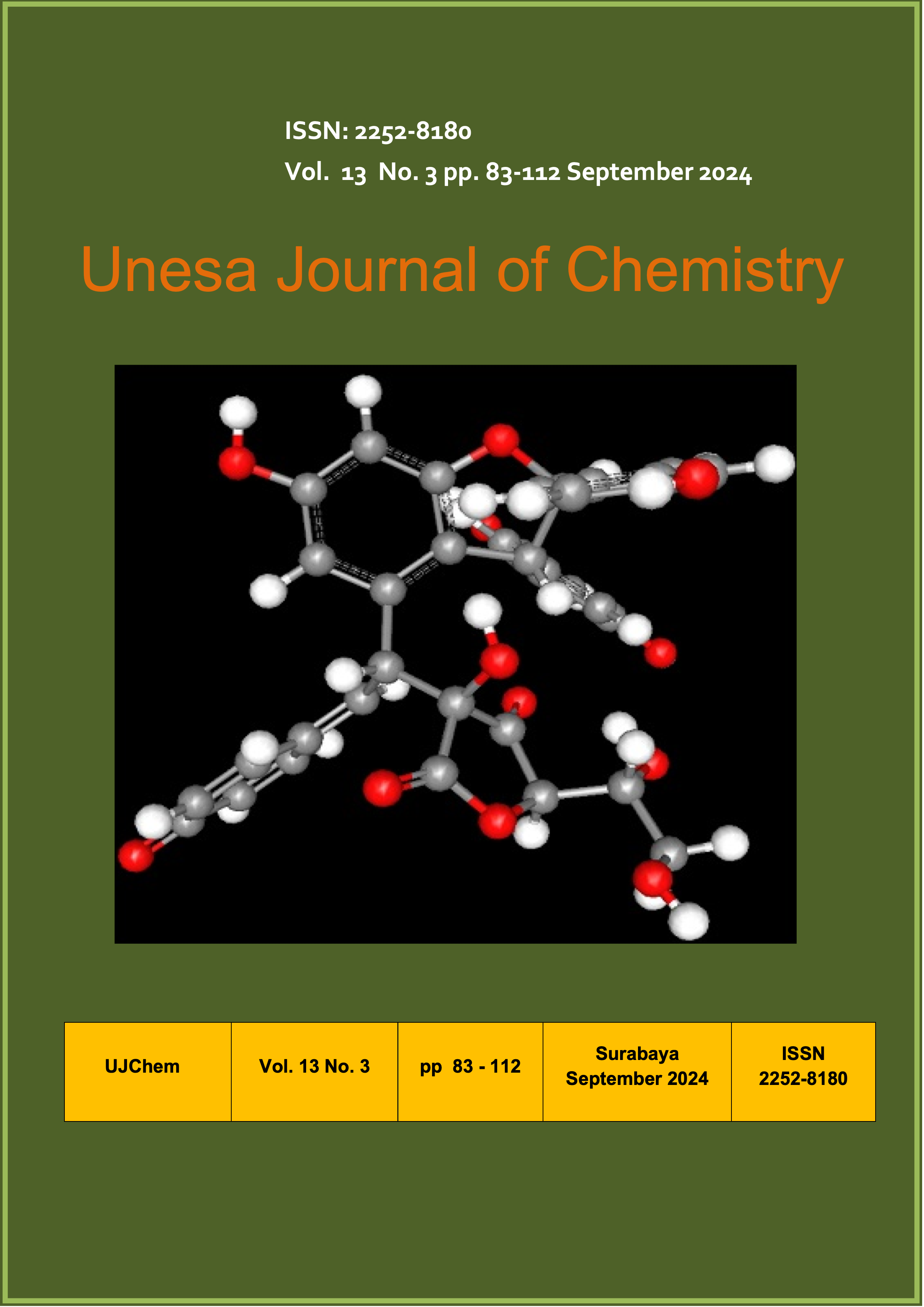REVIEW ARTICLE: BENEFITS OF ALPHA-MANGOSTIN CONTENT IN MANGOSTEEN RIND
Main Article Content
Abstract
Mangosteen, as one of the most popular tropical fruits in Indonesia, has many chemical compounds in its rind that are beneficial for treatment. Alpha-mangostin which is a major component has various activities such as antibacterial, anticancer, and antitumor. Mangosteen peel has the main compound, xanthone. Where there is an important content in inhibiting the growth of cancer cells, and anti-inflammation. In addition, mangosteen peel also has anti-inflammatory compounds such as flavonoids, vitamins B1, B2, C, saponins and tannins which have properties in accelerating healing. In fact, mangosteen peels are used medicinally by Asian populations in the treatment of skin infections and cholera since ancient times. The main and most abundant constituent found in Garcinia mangostana L, the xanthone class is α- mangostin. One of the main compounds in mangosteen pericarp is α- Mangostin. α- Mangostin shows good pharmacological activity as well as from in vivo or in vitro models. α- Mangostin shows strong potential to be used as a drug in the future. However, the application of α-Mangostin in the clinical field is still lacking.
Downloads
Article Details

This work is licensed under a Creative Commons Attribution 4.0 International License.
References
1. Abadelah, M., et al. (2018). AAPS PharmSciTech, 19(1), 251-261.
2. Aisha, A. F., et al. (2014). Pharmaceutical Research, 31(3), 697-707.
3. Attazqiah, R. N., & Ambarwati, N. S. S. (2021). Studi literatur: pemanfaatan ekstrak kulit buah manggis (garcinia mangostana l.) Untuk perawatan kulit wajah. Jurnal Tata Rias, 11(1), 101-110.
4. Ayurie, A. P., & Rahman, S. (2024). Efektifitas Kulit Buah Manggis (Garcinia Mangostana L.) terhadap Kepadatan Kolagen sebagai Penyembuh Luka Bakar pada Tikus Putih Wistar. Jurnal Implementa Husada, 5(3), 204-214.
5. Chae, H. S., et al. (2016). International Journal of Pharmaceutics, 511(1), 276-284.
6. Chomnawang, M. T., Surassmo, S., Nukoolkarn, V. S., & Gritsanapan, W. (2007). Effect of Garcinia mangostana on inflammation caused by Propionibacterium acnes. Fitoterapia, 78(6), 401-408
7. Chin Y, Jung H, Chai H, Keller W and Kinghorn A. 2008. Xanthones with quinine reductase-inducing activity from the fruits of Garcinia mangostana (Mangosteen). Phytochemistry 69(3): 754–758.
8. Noorrohmah, S., Sobir, S., & Effendi, D. (2015). Analisis Keragaman Genetik Manggis Dalam Satu Pohon. Jurnal Hortikultura, 25(2), 106-112.
9. NIDYASARI, R. S., AKMAL, H., & ARIYANTI, N. S. (2018). Karakterisasi morfologi dan anatomi tanaman manggis dan kerabatnya (Garcinia spp.) di Taman Buah Mekarsari. Jurnal Sumberdaya Hayati, 4(1), 12-20.
10. Suksamrarn S, Suwannapoch N, Phakhodee W,Thanuhiranlert J, Ratananukul P, Chimnoi N and Suksamrarn 2003, Antimycobacterial activity of prenylatedxanthones from the fruits of Garcinia mangostana, Chem Pharm Bull (Tokyo).,51(7):857-859
11. Ee, GCL, Daud S, Izzaddin SA and Rahmare M. 2008. Garcinia mangostana: a source of potential anti-cancer lead compounds against CEM-SS cell line. J Asian Nat Prod Res 10(5): 475–479.
12. IDADY, D., Astuti, K. W., & Warditiani, N. K. (2013). Identifikasi kandungan kimia ekstrak kulit buah manggis (Garcinia mangostana L.). Jurnal Farmasi Udayana, 2(4), 279844.
13. Li, L., et al. (2013). European Journal of Drug Metabolism and Pharmacokinetics, 38(4), 263-271.
14. Pothitirat, W., et al. (2015). Planta Medica, 81(12-13), 1085-1092.
15. Rubiyanti, R. (2017). Potensi ekonomi dan manfaat kandungan alfa-mangostin serta gartanin dalam kulit buah manggis (Garcinia mangostana Linn). Farmaka, 15(1), 15-25.
16. Schlegel HG, Schmidt K, 1994. Mikrobiologi Umum. Edisi keenam. Diterjemahkan oleh Georg Thieme Verlag. Yogyakarta: Gadjah Mada University Press.
17. Sharma, A., et al. (2018). Pharmaceutical Development and Technology, 23(7), 1-10.
18. Srihari, E., & Lingganingrum, F. S. (2016). Ekstrak kulit manggis bubuk. Jurnal Teknik Kimia, 10(1), 1-7.
19. Walker, E. B. (2007). HPLC analysis of selected xanthones in mangosteen fruit. Journal of separation science, 30(9), 1229-1234.
20. Wathoni, N., et al. (2019). European Journal of Drug Metabolism and Pharmacokinetics, 44(3), 341-352.
21. Wathoni, N., et al. (2020). International Journal of Nanomedicine, 15, 1485-1498.
22. Zhao, L., et al. (2012). Carbohydrate Polymers, 89(1), 142-147.
23. Zhao, L., et al. (2020). Journal of Controlled Release, 311-312, 43-56
24. Wathoni, N., et al. (2020). International Journal of Nanomedicine, 15, 1485-1498.
25. Pothitirat, W., & Gritsanapan, W. (2009). Pharmaceutical Biology, 47(12), 1192-1197.

